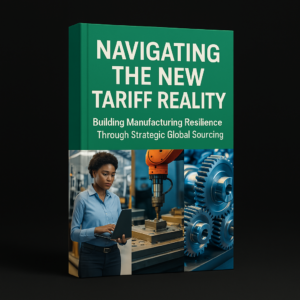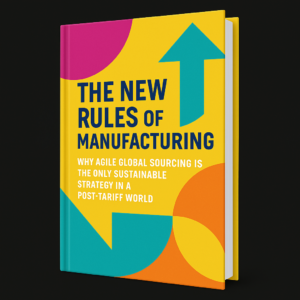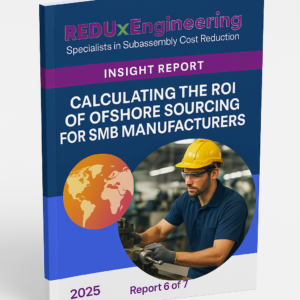
Introduction:
Western manufacturers are at a crossroads: high costs and new tariffs push one way, while technological advancements and shifting markets push another. The final report in this series discusses how adopting a globally diversified manufacturing strategy is key to future-proofing small and mid-sized manufacturers. In essence, by embracing global sourcing and partnerships now, companies can position themselves to ride out economic shifts, access the latest innovations, and scale efficiently. We’ll summarize how the strategies covered (cost optimization, risk mitigation, core focus, etc.) come together to create a resilient and competitive business model for the long run. We’ll also touch on emerging trends (Industry 4.0, regional trade blocs, sustainability concerns) and how a flexible global approach helps address them.
Staying Competitive in the Global Arena:
It’s worth reiterating why all of this matters: Western SMEs no longer only compete with neighbours down the street – they compete with companies across the globe. If your competitor in, say, Germany or Japan is leveraging low-cost production in Asia and you’re not, they can potentially underprice you or invest more in product development. To remain competitive, Western manufacturers must harness global efficiencies. Those who do have seen sustained profit improvements and growth. REDUxEngineering’s clients, for instance, have consistently enjoyed savings on parts and subassemblies in the range of 20–50%, which translate into stronger financial performance and pricing power. When downturns happen or pricing wars occur, these companies have the cushion to survive or even acquire market share from higher-cost rivals. In contrast, firms that ignored offshoring often find themselves squeezed or forced out when major cost disruptions (like tariffs or spikes in local wages) hit.
Building a Resilient Supply Chain:
The events of recent years (trade wars, pandemics, natural disasters) taught the industry that resilience is as important as cost. A global sourcing strategy, if well diversified, actually enhances resilience. You are not betting your entire business on one country or one facility. If political winds change (tariffs, export controls), you have alternatives. If a factory in one country has an issue, you can pivot. By having multiple supply bases, Western manufacturers can weather storms that would cripple a single-source, single-country operation. It’s a bit paradoxical: some thought offshoring increased risk, but in practice exclusive onshoring is its own risk – as the white paper noted, onshoring exclusively can expose you to reciprocal tariffs and leave you uncompetitive internationally. A balanced approach with global partners means you can service different markets from optimal locations (drop-ship to customers from offshore CMs to avoid double tariffs, for example). As supply chain technology (like digital supply chain twins and AI forecasting) improves, managing a distributed network of suppliers becomes easier and more transparent, further reducing perceived complexity.
Harnessing Innovation Worldwide:
Future-proofing is not just about cost and risk – it’s also about innovation. By engaging globally, you tap into a world of ideas and capabilities. Many manufacturing innovations – whether new materials, advanced automation, or process breakthroughs – are happening in manufacturing hubs overseas. When you work closely with offshore partners, you can gain early access to these. For instance, an advanced factory in Asia might implement an AI quality inspection system; as their client, you benefit from improved quality and can learn from that tech. Or consider sustainability: the EU and others are pushing for greener manufacturing. Some of the most energy-efficient, low-emission production techniques might be available via a specialized supplier in, say, Scandinavia or Singapore. A future-proof strategy could mean outsourcing certain processes to partners with the best sustainability profile, thus greening your supply chain faster than you could in-house. In short, a global supply network is also a global knowledge network. It keeps you plugged into the forefront of manufacturing practice, which is crucial as we move into an era of smart factories and digital integration (Industry 4.0).
Flexibility for Market Fluctuations:
Looking ahead, demand patterns can change rapidly. Perhaps you introduce a product that takes off in Asia – you might want to localize production there. Or perhaps a certain product line becomes obsolete – you want to ramp it down without being stuck with unused assets. Global outsourcing provides this flexibility. You can scale up production in markets where needed, or scale down without layoffs by reducing orders to suppliers. Western SMEs that maintain this flexibility will be able to adapt business models quickly (for example, shifting from being a manufacturer to more of a designer/integrator while outsourcing manufacturing entirely if that makes sense). The future likely holds more customization and regionalization of products, and having manufacturing partners around the world means you can produce closer to end markets and even customize products per region with minimal overhead. Many large companies already do this (manufacture in-region for region); SMEs can achieve a similar effect by smart partner selection.
Focus on Core (Revisited) – Future Workforce:
Another future-proofing aspect is talent. There is a demographic challenge in many Western countries with manufacturing skills. Outsourcing less critical production can alleviate the strain of finding and retaining workers for those tasks. Instead, you can focus on hiring in areas like design, engineering, and customer service – roles that are attractive to the next-generation workforce and add high value. Moreover, by partnering with offshore providers, you indirectly leverage their workforce. This can be seen as expanding your team globally without the HR headaches. In a future where skilled labour may be a limiting factor, having access to a global talent pool via partnerships will be crucial. Your core team at home can be smaller, more agile, and focused – which is easier to sustain and scale in a tight labour market.
Sustainability and ESG Considerations:
Future-proofing must consider environmental and social governance (ESG). Stakeholders increasingly demand ethical, sustainable supply chains. Some might question if offshoring aligns with that, but it can – if done thoughtfully. You can choose suppliers that use renewable energy or have good labour practices (many offshore factories are adopting solar power, etc.). Also, the efficiency gains from specialized mass production can sometimes mean lower carbon footprint per unit despite the transport (e.g., a factory in Asia might produce with less waste and optimized energy due to scale). REDUxEngineering also considers these factors when vetting suppliers (we don’t just chase cost, but also quality and compliance). By future-proofing with ESG in mind, you ensure your business will meet upcoming regulations and customer expectations (for example, carbon border taxes could come – having low-cost production in a country with cleaner energy could actually avoid penalties vs. producing in a coal-dependent country). Again, diversification gives options to pivot as needed.
Conclusion:
Western small and mid-sized manufacturers secure their future by embracing a global mindset today. This means leveraging worldwide cost advantages (to stay profitable and price-competitive), building a resilient and flexible supply chain (to handle political and market changes), and focusing their internal efforts on innovation and core value (to differentiate in the market). All the while, maintaining strong oversight and standards to ensure quality and compliance. The strategies discussed – from engineering-driven outsourcing to tariff navigation – collectively form a playbook for sustainable success. Companies that act on these will find themselves more agile, more cost-efficient, and more resilient against whatever the future brings, be it economic swings or technological shifts. In summary, global sourcing isn’t just a reaction to current pressures; it’s a proactive strategy to thrive in the coming decades. With partners like REDUxEngineering shouldering the complexity and risk, even smaller manufacturers can reap the benefits of a global operation without losing sleep. The result: a business that can weather storms and seize opportunities on a global scale, truly future-proof.
References (Report 7):
- REDUx Engineering White Paper (2025) – “A Long-Term Manufacturing Strategy for [Western SMEs]”. Affirms that with 19%–49% savings, offshore sourcing is a “clear winner” for higher-cost Western countries. Also notes it can protect US sales from tariffs and yield stable profits– essentially future-proofing against trade shifts.
- World Economic Forum (2024) – Report on supply chain resilience. Emphasizes diversification and regional balance as keys to withstand disruptions (general reference to support resilience points).
- Bloomberg News (Apr 2025) – Coverage of manufacturers’ responses to tariffs, noting companies splitting supply chains across countries to mitigate impacts (supports the strategy described in Report 4 and future flexibility).
- Tapecon / Manufacturing.net – Discussions on Industry 4.0 adoption in Asia vs West. Indicates many “smart factories” in Asia are at cutting edge, implying companies partnered with them gain innovation advantage. (General insight, no specific cite line).
- OECD Report (2023) – SME Sustainability and Global Supply Chains. Suggests SMEs leverage global suppliers’ sustainability practices to improve their own ESG profile (i.e., partner with greener suppliers to meet climate goals). This supports the idea of using outsourcing to aid sustainability compliance.
#FutureProofManufacturing #GlobalSourcing #SupplyChainResilience #SmartManufacturing #REDUxEngineering #ManufacturingStrategy #Industry40 #SMEGrowth #SustainableSourcing #AgileManufacturing





